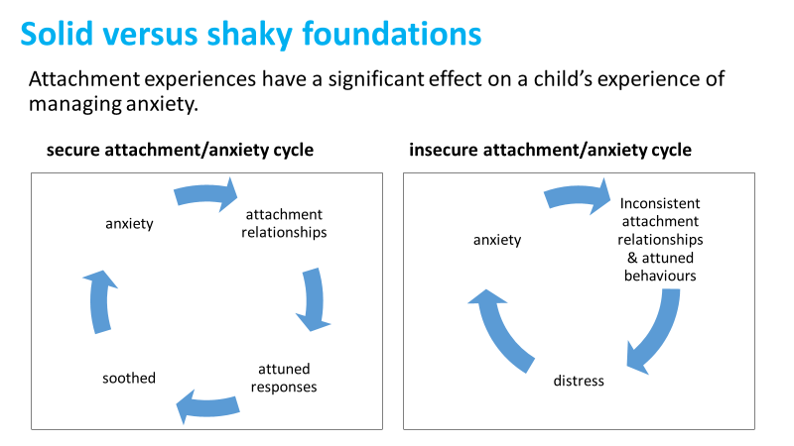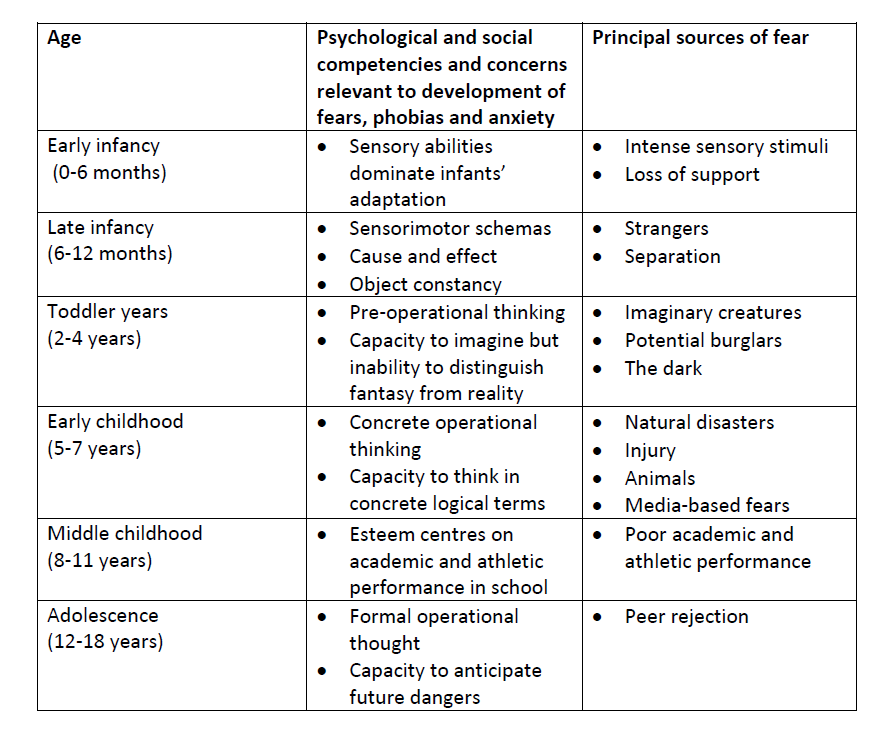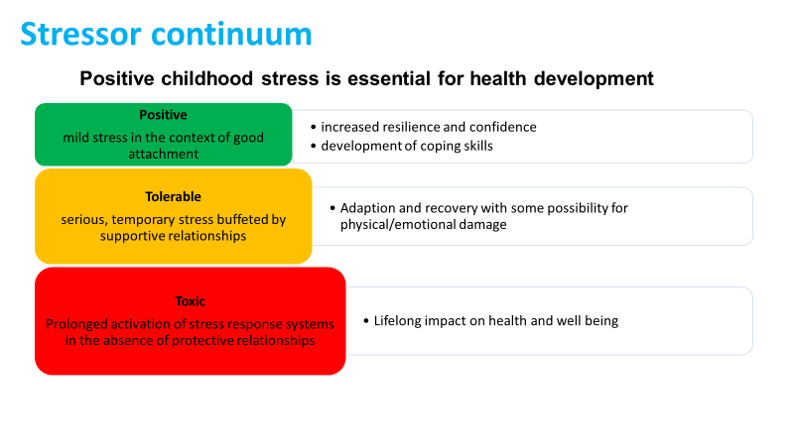Understanding Anxiety
Occasional anxiety is an expected part of life for everyone. Experiencing anxiety at higher levels is also to be expected for children, young people and adults at different times in their development and as a result of different experiences or circumstances in their life. Most anxieties are temporary and are to be expected and understandable, particularly if/when significant life changes have been experienced. Experiencing anxiety and being able to overcome it is an important part of child development.
This video (NSPCC, 2017) explains how a child’s brain develops through early experiences, including the critical role of healthy relationships and how experiencing positive and tolerable stress is essential for development (video is 4.05mins).
This diagram shows the difference between types of stress.
Video explaining stress to young people (Mental Health Literacy, 2020) (5.18mins)
Video explaining anxiety to young people (Anna Freud, 2023) (4.32 mins)
The role of adults
Children’s responses will be significantly influenced by adults around them. Children may need higher levels of reassurance, both through verbal and non-verbal communications. Children are highly attuned to the emotions and behaviours of adults so if adults are anxious or act in ways that are highly different and unpredictable for the children/young people, this is likely to elevate rather than reduce any anxieties children experience. Routines and predictability are protective for those experiencing anxiety.

Typical anxieties for children & young people by age group
A table with typical anxieties that often arise for children and young people by age group is below. Children manifest many fears and anxieties as part of typical development. Although these anxieties might be acutely distressing, they occur in most children and are typically transient. The table is given as a guide. Some children and young people may not experience these anxieties and/or may experience them at a different age/stage of development. Considering this information alongside other assessment information would form part of your holistic assessment to determine the nature of ongoing assessment and intervention required.
Typical anxieties per age group. Adapted from Carr, A. (2015). The Handbook of Child and Adolescent Clinical Psychology: A Contextual Approach. 3rd Ed. Routledge. P402.

What might we notice?
When the level of stress or anxiety is too high for the child/young person to cope with, then we can sometimes see fight, flight, freeze, submit responses. These behaviours are the body’s natural response to danger, a type of stress response that helps you react to perceived threats in your environment, behaviours designed to keep us safe in situations that seem too risky for us.
Townsend, H. (2017) has provided a booklet called ‘What Survival looks like in School’ that explains the freeze, flight, fight, submit responses and what this experience is like for the child/young person. Further resources are available via www.innerworldwork.co.uk
Stress and anxiety causes changes in body, changes in thinking, changes in behaviours.
Changes in body might include feeling tense, sweating, breathing faster, senses being more sensitive, heart beating faster. For every person and in different situations, the body sensations of stress and anxiety will differ. It is important to help a person be ‘in tune’ with these body changes to understand and then intervene effectively.
Changes in thinking might include, being so pre-occupied with the problem or source of the anxiety that it distracts from other thinking and activity, become very rigid in thinking about the source of the anxiety or more generally, being unable to generate and consider solutions to the anxiety. For every person and in different situations, the thinking impacts of stress and anxiety will differ. It is important to help a person be ‘in tune’ with these thinking changes to understand and then intervene effectively.
Changes in behaviours

The iceberg image reminds us that the behaviour(s) that we see from a child/young person (or adult) are a glimpse into the feelings and thinking of the individual.
When someone is anxious they may show behaviours such as anger; avoidance; negativity; desire to control people and events; defiance; lack of focus; sleep issues; crying; having very high expectations of self (or others).
It may also be that the child’s anxiety is higher or more apparent in one context than another. Sometimes an individual might ‘mask’ their anxiety as a way of coping or avoiding showing their true feelings to other people. As above, the behaviour(s) seen (or not seen) is/are not a true reflection of how the person is feeling. It is important that assessment is undertaken to understand the child/young person’s anxiety as making assumptions about what or where (context) the anxiety is related to may miss important information needed to support the child/young person fully.
 In general, these changes in body, thinking and behaviours are natural and temporary in response to positive or tolerable levels of stress or anxiety (see stressor continuum above) that will lead to good learning experiences for children and young people. Even in these circumstances, there will be interventions that will be useful to help the child/young person through this process.
In general, these changes in body, thinking and behaviours are natural and temporary in response to positive or tolerable levels of stress or anxiety (see stressor continuum above) that will lead to good learning experiences for children and young people. Even in these circumstances, there will be interventions that will be useful to help the child/young person through this process.
More detailed assessment is required when children/young people show more prolonged or widespread concerns from stress/anxiety, where the ‘stressors’ have thought to have reduced and the child/young person’s wellbeing is still impacted, or where children/young people may or are known to have signs of toxic stress and anxiety.
Resilience and Universal approaches
Resilience, which is directly related to wellbeing, is having the ability to cope with the inevitable challenges and problems individuals encounter in their life. Resilience is also important in helping us cope with changes and new situations we encounter in our lives. And importantly to learn from these experiences.
There are factors that have been shown to support resilience (Resilience factors). What is critical is that resilience is something that can be developed and enhanced for all children, young people and adults.
For most children, attending education establishments with strong relationship- based practices including nurturing approaches will effectively meet the majority of children’s wellbeing needs. Adults and children can enhance their wellbeing by investing in the wellbeing self-care elements. This is particularly important when additional life changes or challenges are encountered.
While Adverse Childhood Experiences undermine development and negatively affect the foundations of brain growth (see video above), resilience can help repair these structural differences and allow a person recovery from the trauma or adversity they had experienced.
We are encouraged to move away from asking, “What is wrong with you?” to ” We want to understand what happened and what can we do to help”.


